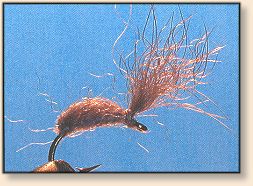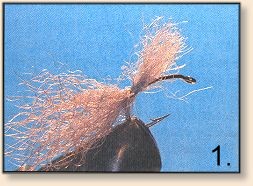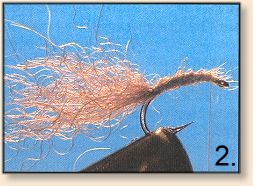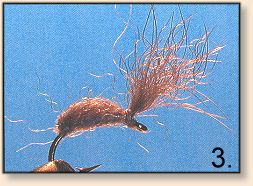Serendipity Flies and the Snowshoe IOBO Humpy

By Sheldon Seale
Some of the deadliest fly patterns have their origins
in serendipity: they were created by accident - by
tyers attempting to tie patterns for which they had
incomplete imformation. I can think of at least half
dozen flies which qualify, including the Canadian version
of Hamill's Killer (watch out for tying instructions for
this effective Maurice Howe varient of a popular New
Zealand pattern in a future issue of The Canadian
Fly Fisher).
However, I IOBO Humpy has the unique distinction of being
a double serendipity fly. It started with the IOBO (short
for It Oughta Be Outlawed), which was created by Jack
Tucker of Pennsylvanis when he was trying to tie a CDC and
Elk (an invention of Hans Weilermann of the Netherlands)
without complete tying instructions. He tied in the CDC
feather by the butt rather than the tip at the bend of the
hook. After he'd wound it forward and tied it off, he was
intrigued by the tuft of tip fibres sticking our over the
eye. Instread of trimming them off, he left them on.
The result was a fly which caught fish when nothing else did
- the IOBO.
But it didn't end there. Tucker tried tying in the CDC
feather by the butt just behind the eye rather than at the
bend, wound it back to the bend, secured it, ribbed the
body with thread, pulled the tip forward over the back, and
tied off leaving the tip out over the eye. Bingo!
The IOBO Humpy, which proved to be equaly, if not more
effective than the original IOBO.
Nevertheless, despite the effectiveness of both IOBO patterns,
they suffer from a major drawback: The CDC tends to slime
up with each fish caught and the fly has to be thoroughly
dried before it can be use effectively again. However,
this problem can be overcome by substituting hair from
the foot of a snowshoe rabbit for the CDC. Showshoe
hair is waterproof and resistant to sliming, which eliminates
the need for painstaking drying.
The Snowshoe IOBO Humpy
This is a small fly, necessitating fine thread and
fine wire hooks. The hook in the photos is a fine wire
scud hook, size 16.
Hook: Any fine wire, down or ring eye dry fly
or scud hook, sizes 16-24.
Thread: 8/0 or 11/0, to match body.
Body: Tuft of snowshoe rabbit foot hair, natural
or dyed dun or olive, secured along hook with thread.
Shellback: Same tuft of hair, tied postlike, angled
out over the hook eye.
Tying Notes

Step 1: I start by cutting out a tuft of snowshoe foot hair
from the middle of the foot where the hair is longest. Remove
some of the underfur and measure the hair to at least twice the
overall hook length. Trim the hair at the butt ends and tie
in at the hook bend, leaving enough of the butt ends to reach
along the hook shank to the eye, with the tips sticking out
beyond the bend.

Step 2: Sprial the thread along the hair along the hook shank
to form the rib. As you are doing this, be sure the hair
surrounds the hook shank. Secure the hair just back of the
hook eye with a couple of tight wraps of thread.

Step 3: Pull the hair tips forward over the back of the fly
and tie the hair down pointing out over the eye with a couple
of turns of thread. To form the wing, take 2-3 turns around
the hair to form a post-like wing that slopes out over the
hook eye. Tie off the thread in front of the post, trim the
thread and apply a little lacquer if you wish.
Fishing Notes
Fish as any dry fly, especially when you can't see any
insect activity. The fly should hang in the surface film,
so any floatant should be confined to the wing. The take
can be subtle, so stay alert.

As this pattern sits so low in the water, it can be difficult
to see. Try a little strike putty about 40 cm up on your
tippet. If you see a swirl or boil near the putty, raise your
rod gently to see if your fly was taken. Remember, it's a
small pattern and it won't take much to break off or pull
off. Just take the slack out of the line and let the fish
do the rest.
As always, we encourage the readers to let the magazine know
about your successes with the patterns described in each
issue. You can contact us by e-mail at
canflyfish@sympatico.ca
or on the Net at www.canflyfish.com
~ Sheldon Seale
Credits:
We thank the
Canadian Fly Fisher for re-print permission!
Our Man In Canada Archives
|





